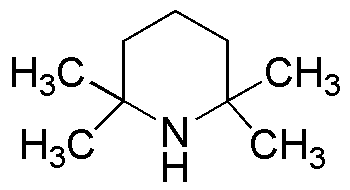2,2,6,6-Tetramethylpiperidine is widely utilized in research focused on:
- Organic Synthesis: This compound serves as a versatile building block in the synthesis of various organic molecules, particularly in the development of pharmaceuticals and agrochemicals.
- Radical Scavenger: It is effective in trapping free radicals, making it valuable in studies related to oxidative stress and aging, as well as in formulations for cosmetics and skincare products.
- Catalysis: This chemical acts as a catalyst in certain reactions, enhancing reaction rates and improving yields in chemical processes, which is crucial for industries aiming for efficiency.
- Polymer Chemistry: It is employed in the production of polymers, particularly in creating high-performance materials that require stability and resistance to degradation.
- Analytical Chemistry: Used as a standard or reference material, it aids in the calibration of analytical instruments, ensuring accurate measurements in various laboratory settings.
General Information
Properties
Safety and Regulations
Applications
2,2,6,6-Tetramethylpiperidine is widely utilized in research focused on:
- Organic Synthesis: This compound serves as a versatile building block in the synthesis of various organic molecules, particularly in the development of pharmaceuticals and agrochemicals.
- Radical Scavenger: It is effective in trapping free radicals, making it valuable in studies related to oxidative stress and aging, as well as in formulations for cosmetics and skincare products.
- Catalysis: This chemical acts as a catalyst in certain reactions, enhancing reaction rates and improving yields in chemical processes, which is crucial for industries aiming for efficiency.
- Polymer Chemistry: It is employed in the production of polymers, particularly in creating high-performance materials that require stability and resistance to degradation.
- Analytical Chemistry: Used as a standard or reference material, it aids in the calibration of analytical instruments, ensuring accurate measurements in various laboratory settings.
Documents
Safety Data Sheets (SDS)
The SDS provides comprehensive safety information on handling, storage, and disposal of the product.
Product Specification (PS)
The PS provides a comprehensive breakdown of the product’s properties, including chemical composition, physical state, purity, and storage requirements. It also details acceptable quality ranges and the product's intended applications.
Certificates of Analysis (COA)
Search for Certificates of Analysis (COA) by entering the products Lot Number. Lot and Batch Numbers can be found on a product’s label following the words ‘Lot’ or ‘Batch’.
*Catalog Number
*Lot Number
Certificates Of Origin (COO)
This COO confirms the country where the product was manufactured, and also details the materials and components used in it and whether it is derived from natural, synthetic, or other specific sources. This certificate may be required for customs, trade, and regulatory compliance.
*Catalog Number
*Lot Number
Safety Data Sheets (SDS)
The SDS provides comprehensive safety information on handling, storage, and disposal of the product.
DownloadProduct Specification (PS)
The PS provides a comprehensive breakdown of the product’s properties, including chemical composition, physical state, purity, and storage requirements. It also details acceptable quality ranges and the product's intended applications.
DownloadCertificates of Analysis (COA)
Search for Certificates of Analysis (COA) by entering the products Lot Number. Lot and Batch Numbers can be found on a product’s label following the words ‘Lot’ or ‘Batch’.
*Catalog Number
*Lot Number
Certificates Of Origin (COO)
This COO confirms the country where the product was manufactured, and also details the materials and components used in it and whether it is derived from natural, synthetic, or other specific sources. This certificate may be required for customs, trade, and regulatory compliance.


